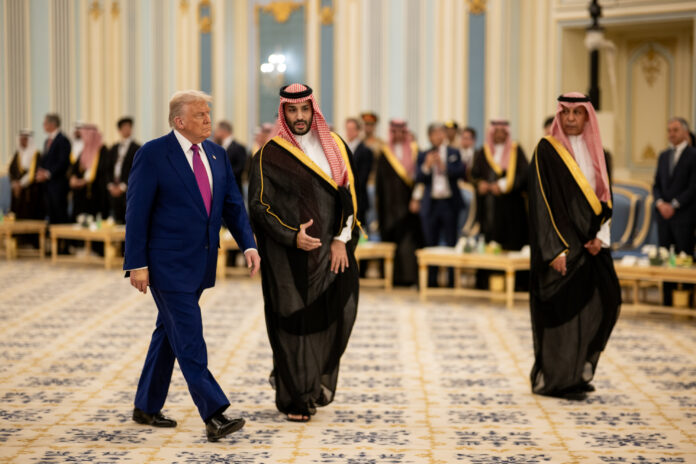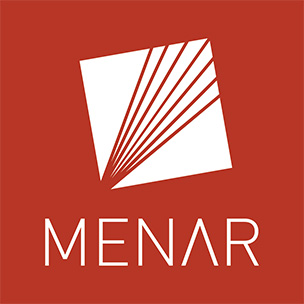By Mirna Fahmy
In a move echoing the pattern of his previous presidency, the 47th President of the United States, Donald J. Trump, made the Middle East — and specifically the Gulf — his first international destination following his inauguration. From May 13 to 17, Trump visited Saudi Arabia (May 13–14), Qatar (May 14), and concluded in the United Arab Emirates (UAE) (May 15–16), unveiling a series of high-level talks framed by gilded promises of trillions in deals.
These trillions refer to a web of massive investment pledges, renewed strategic partnerships, and ambitious declarations of regional peace and security. While official statements emphasize mutual interests and economic cooperation, the underlying message appears to be transactional: a transfer of Gulf wealth into the U.S. economy in exchange for continued American security guarantees.
This explicit quid pro quo has drawn sharp commentary across the region. Some political analysts, in a controversial analogy, have described Trump’s approach as a modern form of collecting “al-Jizya” — referencing the historical tax imposed by Islamic caliphates on non-Muslim populations in return for protection.
The Official Itinerary: Gulf Tour as Strategic Transaction
Trump’s inaugural overseas trip of his second term, spanning from May 13 to 17, 2025, was a meticulously orchestrated tour through the Gulf states, underscoring a blend of diplomatic engagement and substantial economic agreements. The total pledged amount from these countries has reached $ 2.2 trillion.
Saudi Arabia (May 13–14)––Pledges of Massive Investment. In Riyadh, Trump was received with ceremonial grandeur by Crown Prince Mohammed bin Salman. Central to the visit was the announcement of Saudi Arabia’s intention to invest one trillion dollars up from $600 billion in the United States over the next four years. This pledge encompasses sectors such as defense, technology, and infrastructure, aligning with the Kingdom’s Vision 2030 initiative aimed at economic diversification .
A significant highlight was the launch of “Humain,” a Saudi artificial intelligence company under the Public Investment Fund. During Trump’s visit, Humain secured partnerships with major U.S. tech firms, including Nvidia, AMD, and Qualcomm, signaling a deepening of technological collaboration between the two nations.
Qatar (May 14)––Aviation Deals and Diplomatic Nuances. In Doha, Trump oversaw the signing of a monumental agreement between Qatar Airways and Boeing for the purchase of 160 aircraft, valued at approximately $1.2 trillion, according to the White House. This deal is touted as the largest in Boeing’s history, although details regarding the specific aircraft models and the nature of the orders remain undisclosed .
The visit was marked by a distinctive motorcade featuring Tesla Cyber Trucks, symbolizing a fusion of modernity and tradition. Additionally, reports emerged about Qatar’s intention to give Trump a luxury Boeing 747-8 jet for use as Air Force One, a gesture that has sparked discussions concerning ethical and legal implications under U.S. law.
Furthermore, Qatar committed to investing $10 billion in the Al Udeid Air Base, the largest U.S. military facility in the Middle East . Trump is considered to be the first US president to visit Qatar since its establishment as an independent state from “the Arab Peninsula.” He even gave a speech to the US military base there and put on his favorite dance move. Defense agreements totaling $38 billion were also announced, strengthening the military partnership between the two nations .
UAE––Advancing AI and Infrastructure. Trump concluded his Gulf tour in the UAE from May 15 to 16. The UAE reaffirmed its earlier pledge of a $1.4 trillion investment in the U.S. economy over the next decade, focusing on artificial intelligence, semiconductor manufacturing, and energy infrastructure .
The visit also included discussions on expanding AI collaborations, with U.S. tech firms like Nvidia and AMD securing deals to supply AI chips and establish data centers in the region .
Elon Musk accompanied Trump during this visit, and he made a significant announcement regarding SpaceX’s Starlink service, which Saudi Arabia authorized for aviation and maritime shipping.
At the end of his Gulf tour, Trump who is thrilled to meet his eleventh grandson, has announced that now “the US has investments of $10 trillion, and they are heading to reach between $12 trillion and $14 trillion, some of which have been announced and some of which will be announced soon.”
Power Games in the Gulf: Motives of the Host
A key focus of Trump’s agenda is the Abraham Accords, with his administration pushing for Saudi Arabia’s inclusion to build regional peace and cooperation, despite current normalization efforts being hindered by the Gaza conflict and Palestinian issues.
Trump expressed his strong desire and “dream” for Saudi Arabia to join the Abraham Accords, the series of normalization agreements between Israel and several Arab countries (including the UAE and Bahrain) that were originally brokered during his first presidential term on September 15, 2020. He articulated this aspiration during his speech at an investment conference in Riyadh, emphasizing that Saudi Arabia’s participation would be a historic step for the Middle East.
However, Trump acknowledged that Saudi Arabia would join “in its own time,” reflecting Riyadh’s current reluctance to normalize ties with Israel amid the ongoing Gaza conflict and lack of progress toward a two-state solution for Palestinians. Saudi officials have indicated that normalization is contingent on meaningful resolution of the Gaza war and Palestinian statehood.
With the help of mediating efforts from Saudi Arabia and Qatar, Trump met Syria’s new president Ahmed Al Sharaa (aka Abu Muhammed al-Julani) in Riyadh. Trump announced the lifting of U.S. sanctions on Syria following the fall of the Assad regime, to prevent further unrest and instability from spreading in Syria and the broader region. This marked a significant shift in U.S. policy, opening a path for Syria’s reintegration into regional diplomacy and reconstruction efforts. It is unclear how will the US-Syrian relations that has finally incite a positive effect in 25 years while still the sectarian attacks are continuing not only in the Syrian Coast but in many cities against the non-Sunni Muslim people who are the Alawites, Druze and Christians.
Trump has also urged al-Sharaa to join the Abraham Accords with Israel and take bold steps towards regional peace. Al Sharaa has revealed during his visit in France this month that Syria and Israel are in negotiations indirectly and Syria is aiming for peace with Israel. Although Trump announced that al-Sharaa had agreed to join the Abraham Accords and eventually recognize Israel, Syria has not officially confirmed this agreement.
Pressuring Iran, Trump used the visit to intensify demands on Iran to comply with nuclear program limitations, warning of military consequences if Iran refuses to negotiate. The visit underscored ongoing U.S. efforts to curb Iran’s regional influence and nuclear ambitions.
In an effort to avert wider Middle East conflict, Trump sought to mediate tensions related to the Gaza war and the humanitarian crisis, engaging with Gulf leaders on possible solutions despite Israel’s ongoing military operations. Discussions included attempts to halt rocket fire from Houthi rebels in Yemen, though these negotiations notably excluded Israel, signaling a shift in traditional alliances.
Rift with Israeli Leadership––the trip highlighted growing differences between Trump and Israeli Prime Minister Benjamin Netanyahu, especially over approaches to Gaza, Syria sanctions, and negotiations involving regional security. While the U.S.-Israel alliance remains intact, Trump’s dealings with Gulf states and Syria without Israeli involvement mark a departure from previous U.S. Middle East policy.
Israel is excluded
Trump’s trip was designed to secure massive investment and arms deals with Saudi Arabia, Qatar, and the UAE-countries that could offer the U.S. significant commercial and strategic benefits. Israeli officials and analysts noted that, unlike the Gulf states, Israel currently has little to offer Trump in terms of major economic agreements or investments that align with the goals of this particular tour.
The ongoing and intensifying Israeli military campaign in Gaza has strained Israel’s relations with its Arab neighbors, especially Saudi Arabia. Saudi officials have publicly condemned Israeli actions in Gaza, labeling them as genocide, making it diplomatically untenable for Saudi Arabia or other Gulf states to pursue normalization with Israel at this time. Including Israel in the trip would have complicated Trump’s ability to finalize deals and could have undermined the summit’s objectives.
Despite continued rhetorical support for Israel, there are signs of growing distance between Trump and Netanyahu. Trump has pursued negotiations with Iran and the Houthis, sometimes against Israeli wishes, and has publicly expressed frustration with what he perceives as Israel’s lack of reciprocal benefit to the U.S. compared to the Gulf states.
Trump reportedly considered visiting Israel if he could announce a major achievement, such as a Gaza ceasefire or a breakthrough on humanitarian aid. However, with Israel preparing to escalate its military operations and no significant diplomatic progress achieved, there was little incentive for Trump to make Israel part of the itinerary.
In Saudi Arabia, Trump pledged a commitment to global peace, linking it to both regional stability and economic partnership. He acknowledged the humanitarian crises in Gaza and Syria, calling for international cooperation, and declared the Middle East poised for a “new era.”


